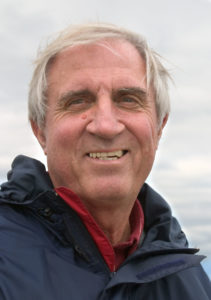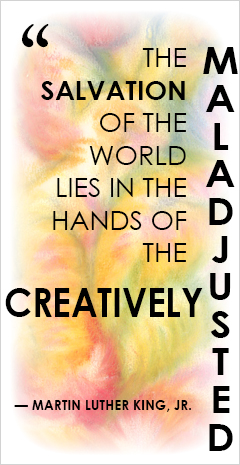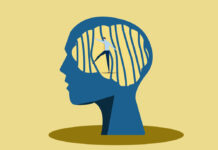Martin Luther King, Jr. once said that the “salvation of the world lies in the hands of the creatively maladjusted.” He believed that it is not the conforming and unquestioning majority, but the disciplined and positive nonconformists, acting from a place of love and nonviolent revolution, that often bring about needed change in our society.
These are the same anti-authoritarians that might be labeled with “oppositional defiance disorder,” “conduct disorder,” borderline personality disorder,” or simply as MAD. Certainly they see things differently – they see our society as it truly is (with all its problems), and they have a vision of society as it might be, could be, ought to be.
Some of the most creatively maladjusted go further than just vision; they aim to realize that vision.
It is these individuals and their inspirational actions that we would like to share with you over the coming months in our “Profiles in Creative Maladjustment” series.
And it is the spirit of creative maladjustment that drives their varied activism and projects that we are gearing up to CELEBRATE this July 7-14 during the first annual Creative Maladjustment Week. (Learn more at: www.cmweek.org and www.facebook.com/iaacm)
Will you join us?
***
Profile in Creative Maladjustment:
AL GALVES
Creatively maladjusted to the ideology of the “chemical imbalance”
A LEGACY OF ACTIVISM
 My path to becoming an activist began at a young age. My parents were both visionaries in their own ways. They both saw the possibility of creating a world in which all people would be able to live satisfying lives. They both were strong supporters of the Civil Rights Movement. My mother and father were early financial supporters of the Southern Christian Leadership Coalition which was the organization that supported Martin Luther King’s work. My mother provided a home for a high school junior from Mississippi who spent a year going to high school in our home town of Nyack, New York.
My path to becoming an activist began at a young age. My parents were both visionaries in their own ways. They both saw the possibility of creating a world in which all people would be able to live satisfying lives. They both were strong supporters of the Civil Rights Movement. My mother and father were early financial supporters of the Southern Christian Leadership Coalition which was the organization that supported Martin Luther King’s work. My mother provided a home for a high school junior from Mississippi who spent a year going to high school in our home town of Nyack, New York.
My mother was also a social worker who helped immigrants get settled in the New World. Although my father was a businessman who benefited financially from war time, both he and my mother were vehemently opposed to the Vietnam War.
As a college student I was very concerned about the problem of workers being displaced by automation and the need to provide them with retraining and relocation help. When I went to work for the City of Albuquerque with a freshly minted Master’s degree, I quickly got myself transferred over to the Model Cities (antipoverty) program where I was in charge of employment and economic development programs.
MENTAL HEALTH ACTIVISM
The seeds of my mental health activism were sown when I fell into a severe depression at age 25. When I went to quit my job my boss fortunately got me hooked up with a classically trained psychoanalyst. I started getting better after the third or fourth session. Since then I have been helped by 12 psychotherapists and attended two personal growth programs and received training in a variety of psychotherapeutic approaches. I also practiced as a psychotherapist for 9 years. So I’m a big believer in psychotherapy. It has helped me a lot and I think I have used it to help many of the people I worked with as a therapist.
A BATTLE AGAINST PSYCHOTHERAPY
I became aware of the battle against psychotherapy in the late 1980’s when the National Alliance for Mental Illness (NAMI) began to gain some traction with its belief that “mental illnesses” were caused by chemical imbalances and genetic anomalies and that drugs were good treatment. Since that time, there has been a steady increase in the amount of psychotropic drugs that are being taken by Americans.
I knew this was wrong and that it was going to hurt a lot of people. It was going to hurt people because it was going to give them a horribly wrong message: “What is going on with you is just a chemical imbalance or some genetic dynamics. It doesn’t have anything to do with you or your life and how you are reacting to it. Just take these pills.”
Thinking this way, people would be deprived of the opportunity to become more accepting of what was true about themselves, to develop some compassion for themselves and to get on the path of learning how to use their thoughts, emotions, intentions, perceptions, reactions and behavior to build better lives for themselves.
I knew this was wrong because I had benefited so much from psychotherapy.
How had it helped me? It helped me see that my symptoms were caused by deep concerns I had about myself and my life. Was I going to be successful in the kind of work I wanted to do? Did I have what it takes? Would I be able to satisfy my wife sexually? Why was it so important for me to be better than other people, to win the race? Where did that come from? Was it OK that I hated my father? I had been under a lot of stress for a long time and using lots of energy to hide those concerns from myself and others. The depression was a protective move by my bodymind and a wake-up call that I had better do something about this.
Psychotherapy helped me see how I used my thoughts to stop myself from getting what I wanted, how various kinds of fears, including the fear of success, kept me from living the way I wanted to live. It also helped me develop some compassion for myself. I wasn’t born this way. Where did this “bad” stuff come from? It also helped me to become more clear about what I wanted and what I would have to do to get it, how I would have to change some of my thinking, intending, reacting, perceiving and behaving. So psychotherapy was very helpful to me.
HELPING HEALTHY PEOPLE LIVE BETTER LIVES
When I started studying for my Ph.D., I wanted to find ways in which psychology could be used to help healthy people live better lives, not just as a tool for helping “sick” people get better.
As I began practicing as a psychotherapist I focused on learning various ways in which I could help patients. I wanted to be able to use different approaches. As I learned and worked, I became more able to help people. All of the time I was practicing many of my patients were taking the drugs. I realized that I couldn’t do much about that. I would recommend that they not take the drugs but many of them continued to use them.
PROMOTING LIFE-ENHANCING APPROACHES
When I was ready to retire I wanted to get involved in the movement to stop the use of the drugs and to promote more safe, humane, life-enhancing approaches to helping people. I knew Peter Breggin was a psychiatrist who was opposed to the drugs and electroshock. So I Googled him, called him and spoke with his wife who told me about the upcoming conference of the International Center for the Study of Psychiatry and Psychology (ICSPP). I went to the conference.
One of the speakers was David Oaks. He opened my eyes to the problems of human rights violations and the relative powerlessness of psychiatric survivors. In 2003, I went to the MindFreedom protest of the American Psychiatric Association convention in San Francisco and then helped with the hunger strike. I met some of the board members and later that year was asked to be on the board. That was a great step for me, to become associated with David and the board members. I also became more involved in helping ICSPP and eventually was elected to the board of directors [Learn more about MindFreedom International at: www.mindfreedom.org].
AGAINST THE IDEOLOGY OF “CHEMICAL IMBALANCES”
To me, the biggest issue is the slow demise of psychotherapy and other safe and effective approaches to helping people. Also, there’s the horrible message people get that their symptoms are just caused by chemical imbalances and genetics and there’s not much they can do about it except take pills. Those ideas are dehumanizing and wrongheaded and so hurtful to people.
When you add the harm that is done by the drugs, the damaging side effects and the fact that people who use the neuroleptics die on average 25 years younger than other people, it is a national tragedy. And it’s amazing that people don’t realize that.
I also hate the belief that people who are diagnosed with “serious mental illnesses” don’t know what’s good for them and can’t be trusted to make good decisions about themselves.
So I’ve been extremely fortunate to have found MindFreedom and the terrific people who make it up and move it along. It has given me a group of passionate, committed, smart, powerful fellow travelers with whom I can go into battle. That’s the way I see it. It is a battle for the hearts and minds of people, for the victory of truth over error and for saving lives.
MY CREATIVE MALADJUSTMENT
To me, creative maladjustment means seeing what is wrong in the world and saying “This is wrong. This is unjust. I’m not going to adjust to it or say ‘Oh well, that’s the way it is and we can’t do anything about it.’ No, I’m going to do what I can to change it.
The first step is helping other people to see, to become aware of what is wrong and unjust.”
To me, there are three great injustices and wrongs in the United States.
1. The horrible way in which we “treat” people who are diagnosed with mental illnesses.
2. The presence of millions of people who are poor and discouraged through no fault of their own and our unwillingness to do much to help them. One of the results of this failure is the great inequality of wealth and income that hurts our country a lot.
3. The oppressive and inhumane environment of the typical public school in the United States. Our public schools are very hurtful to the millions of children and adolescents who don’t fit into the very narrow range of abilities and behavior which the schools value. Our children spend their days in educational institutions which don’t care what each individual student wants to learn, how s/he wants to learn it and when s/he want to learn it. What a waste.
What we can do about these injustices and wrongs is sound the alarm, shine the light, join with others who want to fight, draw more others into our fold and eventually make a difference through protest, teaching, public information, public advertising, and eventually taking over the institutions that can do something about this – the mental health system, the local, state and federal governments and the public school system.
***
What are YOU creatively maladjusted to? And what are YOU going to do about it during Creative Maladjustment Week (July 7-July 14)?
Tell us at www.cmweek.org/endorse
















Fantastic essay Al, and I certainly share your interest in psychotherapy and its traditional exploration of our “not-so-conscious” motivations. However I find much of our creative maladjustment takes for granted a need to fight “them” and “their” mistaken view of humanity, while desiring ti remain in denial about the subconscious nature of “we?”
Hence when I post excerpts from scientists like Allan N Schore, a subconscious reaction grabs many of my brothers and sisters by the throat, as they “tar” them with the same subconscious brush they feel they been tarred by, ie, the metaphor of a “chemical imbalance.”
As Professor Stephen Porges points out, there has been a commercially driven mismatch between science discovery and its clinical application, leading to a “reaction” that wants to throw the baby out with the bathwater. Yet there honorable scientists like Schore, Porges, Panksepp and many others who seeking to free us from our taken for granted, subconscious reactivity, so often rationalized as a sense of reason.
My own sense of creative maladjustment seeks to walk the line between reason and reaction, in understanding the “illusion” of an “us vs them” worldview which is created by my own need to “fight” for my sense of self. My self-esteem.
Allan N Schore wants to take psychiatry back to its roots, in exploring the subconscious nature of our “projected” needs. I can only implore my brothers and sisters not to throw the baby out with the bathwater, in an understandably pain fueled reaction to the commercially driven mismatch between neuroscience discovery and clinical application. Which is essentially down to our need for “comfort & ease” or “homeostasis” to use the science term. Its easier to write a prescription than sit with a fellow human being and explore the raw energies of our evolved nature. Please consider;
“The Science of the Art of Psychotherapy :
Toward a New Paradigm of Psychotherapy
For the last two decades, I have argued that no theory of human functioning can be restricted to only a description of psychological processes; it must also be consonant with what we now know about biological structural brain development. Three other themes that continue from literally the first paragraph of the first book are that the early stages of life are critical to the development of all later evolving structures and functions, that emotion is central to a deeper understanding of the human condition, and that unconscious processes lie at the core of the self, throughout the life span. The book thus also attempted to reintegrate psychoanalytic ideas of the unconscious mind into developmental science. Affect Regulation and the Origin of the Self— which is now in its 14th printing— was the first book to document not the cognitive development, but the social-emotional development of the infant.
Now it is true that the current surge of research is being fueled by advances in a variety of cutting-edge neuroimaging technologies that can observe and document ongoing brain structure– function relationships. The reader should note there is a major limitation to current in vivo imaging techniques— their limited temporal resolution does not allow them to capture the real-time dynamics of brain function. But even future advances in technology would not be enough. We also need an integrative psychoneurobiological theoretical model that can not only generate testable hypotheses but also conceptualize the vast amount of research and clinical data in a meaningful way.
And we need an interpersonal neurobiological perspective that can account for brain-to-brain interactions. As editor of the Norton Series on Interpersonal Neurobiology, I see this quantitative leap and qualitative shift in emotion research as a powerful source of updated models of psychotherapeutic interventions that are grounded in developmental, affective, and social neuroscience. It is now clear that psychotherapeutic changes in conscious cognitions alone, without changes in emotion processing, are limited. In fact, a clash of psychotherapy paradigms can currently be seen, especially in the treatment of more severe disorders that present with a history of relational trauma and thereby a deficit in affect regulation. In such cases emotion more than cognition is the focus of the change process, and so CBT is now being challenged by updated affectively focused psychodynamic models, including ART. In his most recent book my colleague Philip Bromberg (2011) also describes the paradigm shift in psychotherapy:
Interpersonal and Relational writers largely have endorsed the idea that we are in fact confronted with a paradigm change and have conceptualized it as a transformation from a one-person to a two-person psychology. I feel that this formulation is accurate, and that three central clinical shifts are intrinsic to the conceptual shift: A shift from the primacy of content to the primacy of context, a shift from the primacy of cognition to the primacy of affect, and a shift away from (but not yet an abandonment of) the concept of “technique.” (p. 126)
The current radical expansion of knowledge and paradigm shift has wider implications beyond the mental health professions to the cultural and political organization of societies. In my 2003 volumes I argued that the right hemisphere nonconscious implicit self, and not the left conscious explicit self, is dominant in human adaptive survival functions. Offering data at the neuropsychological, cultural, and historical levels, McGilchrist (2009) echoes this principle:
“If what one means by consciousness is the part of the mind that brings the world into focus, makes it explicit, allows it to be formulated in language, and is aware of its own awareness, it is reasonable to link the conscious mind to activity almost all of which lies ultimately in the left hemisphere” (p. 188).
He adds, however, “The world of the left hemisphere, dependent on denotative language and abstraction, yields clarity and power to manipulate things that are known, fixed, static, isolated, decontextualized, explicit, disembodied, general in nature, but ultimately lifeless” (p. 174). In contrast, “the right hemisphere … yields a world of individual, changing, evolving, interconnected, implicit, incarnate, living beings within the context of the lived world, but in the nature of things never fully graspable, always imperfectly known— and to this world it exists in a relationship of care” (p. 174). Indeed, the “emotional” right hemisphere “has the most sophisticated and extensive, and quite possibly most lately evolved, representation in the prefrontal cortex, the most highly evolved part of the brain” (p. 437).
An essential tenet of McGilchrist’s volume (2009) is expressed in its title: the right hemisphere is the master, and the left the emissary, which is willful, believes itself superior, and sometimes betrays the master, bringing harm to them both. Offering interdisciplinary evidence that spans the sciences and the arts, he convincingly argues that the left hemisphere is increasingly taking precedence in the modern world, with potentially disastrous consequences. I agree that especially western cultures, even more so than in the past, are currently overemphasizing left brain functions.
Our cultural conceptions of both mental and physical health, as well as the aims of all levels of education, continue to narrowly overstress rational, logical, analytic thinking over holistic, bodily based, relational right brain functions that are essential to homeostasis and survival. It is ironic that at a time when clinicians and researchers are making significant breakthroughs not only in right brain social-emotional models of optimal development but also in right brain models of the etiologies and treatment of a wide range of psychopathologies, strong economic and cultural inhibitory restraints and cutbacks are being felt by practitioners. How can we understand this? We are constantly told that the reason for this lies in objective economic factors. But the paradigm shift in psychology and neuroscience suggests subjective unconscious forces are at play here.
Listen to McGilchrist’s (2009) description of what the world would look like if the left hemisphere were to become so far dominant that, at the phenomenological level, it managed more or less to suppress the right hemisphere’s world altogether. He imagines that this left-brained world would lead to an increasing specialization and technicalizing of knowledge, as well as the following: increased bureaucratization, inability to see the big picture, focus on quantity and efficiency at the expense of quality, valuing technology over human interaction, lack of respect for judgment and skill acquired through experience, and devaluing of the unique, the personal, and the individual. Even more specifically;
Knowledge that came through experience, and the practical acquisition of embodied skill, would become suspect, appearing either a threat or simply incomprehensible.… The concepts of skill and judgment, once considered the summit of human experience, but which come only slowly and silently with the business of living, would be discarded in favor of quantifiable and repeatable processes.… Skills themselves would be reduced to algorithmic procedures which could be drawn up, and even if necessary regulated, by administrators, since without that the mistrustful tendencies of the left hemisphere could not be certain that these nebulous “skills” were being evenly and “correctly” applied.… [F] ewer people would find themselves doing work involving contact with anything in the real, “lived” world, rather than with plans, strategies, paperwork, management and bureaucratic procedures.… Technology would flourish, as an expression of the left hemisphere’s desire to manipulate and control the world for its own pleasure, but it would be accompanied by a vast expansion of bureaucracy, systems of abstraction and control. (McGilchrist, 2009, p. 429)
Sound familiar? I suggest that this “imagined” left brain worldview now dominates not only our culture but also the current mental health field in the following forms: an overemphasis on psychopharmacology over psychotherapy, an undue influence of the insurance industry on defining “normative” and “acceptable” forms of treatment, an overidealization of “evidence-based practice,” an underappreciation of the large body of studies on the effectiveness of the therapeutic alliance, a trend toward “manualization” of therapy, a training model that focuses on the learning of techniques rather than expanding relational skills, and a shift of psychotherapy from a profession to a business.
Can we reverse this current imbalance of the hemispheres? The paradigm shift has generated a quantum leap in our attempts to understand a number of fundamental questions of the human condition that can be elucidated by recent discoveries of the early developing right brain. A prime example is the surge of deeper explorations of our human origins by contemporary developmental science. In 2005 Insel and Fenton articulated this widely held principle:
“Most mental illnesses … begin far earlier in life than was previously believed” (p. 590). More recently Leckman and March (2011) are asserting that “A scientific consensus is emerging that the origins of adult disease are often found among developmental and biological disruptions occurring during the early years of life” (p. 333).
We need, now, to use recent knowledge in order to reflect more deeply and act more directly on what is required— at levels of the individual, family, and culture— to provide an optimal human context for both mental and physical health. In addition to culturally supporting the development of intellectual and cognitive abilities, we need to foster the individual’s adaptive capacity to relate socially and emotionally to other human beings via the right brain functions of intersubjective communication, affect processing, empathy, and interactive stress regulation. The large body of studies on the critical survival functions of the right brain can be applied not only to individuals but also to cultures (Bradshaw & Schore, 2007; Schore & Schore, 2008).
Here in the United States, how are we reacting to this crisis at the core of our culture? And if we are not responding, why not? In clinical models we speak of individuals having intrapsychic defenses against uncertainty, stress, and painful negative information. But defenses such as denial, repression, and even dissociation are collectively used by the culture to avoid more directly confronting the serious stressors that lie at its core. Forty years ago Jacob Bronowski offered the trenchant observation, “Think of the investment that evolution has made in the child’s brain.…
For most of history, civilizations have crudely ignored that enormous potential. In fact the longest childhood has been that of civilization, learning to understand that” (1973, p. 425). In a current attempt to overcome that resistance and bring this problem closer to the forefront of cultural consciousness, my colleagues and I are producing two multiauthored volumes: Evolution, Early Experience and Human Development: From Research to Practice and Policy (Narvaez, Panksepp, Schore, & Gleason, in press), and The Impact of Early Life Trauma on Health and Disease: The Hidden Epidemic (Lanius, Vermetten, & Pain, 2010).
Grounded in recent developmental neuroscience, psychiatry, and developmental psychology, these books cast light upon a number of serious psychological and social problems underlying our cultural blind spots. But more than that, contributing scholars from multiple disciplines offer practical thoughts about what types of early-life experiences are essential for optimal development of human brain and body systems— in order not only to generate greater understanding of scientific research and theory but also to promote informed public policy.
In a recent overview of contemporary developmental neuroscience, Leckman and March (2011, p. 333) conclude, “our in utero and our early postnatal interpersonal worlds shape and mold the individuals (infants, children, adolescents, and adults and caregivers) we are to become.” At this point in time there is converging evidence that we can maximize the short- and long-term effects of our interventions by concentrating on the period of the brain growth spurt— from the last trimester of pregnancy through the second year. Whether or not our governments will fund such sorely needed efforts remains to be seen.”
Excerpts from “The Science of the Art of Psychotherapy” by Allan N. Schore.
I’m sure there will a rash of comments concerning my “perceived” betrayal of an “expected” norm, here on MIA’s predominately “us vs them” worldview. Yet I wonder just how self-aware people are, when they fail to pause and catch the gap between the spark and the flame of their “musculature entrained” thinking and its “postural attitude” of hurt, pain, anger-rage and revenge, normally rationalized as a sense of reason, in our hatred of “them.”
In solidarity and creative maladjustment,
My sincere regards,
David Bates.
Report comment
Al,
Thank you for your work with ISEPP.
Re: ” Our public schools are very hurtful to the millions of children and adolescents who don’t fit into the very narrow range of abilities and behavior which the schools value.”
Comment: As a retired rehabilitation counselor, I agree with you.
We need to learn to VALUE the unique way in which these kids see and respond to our world.
We need to remain cognizant of the *fact* that these kids are GIFTS!
Duane
Report comment
Hi Duane,
Beyond the too often insular and “paranoid” worldview of “us & them” here on MIA, your hopeful desire for future generations is actually happening “out-there.” Where many are trying to take a more “emotionally balanced” view of life.
Check out this great video of America’s young and talented children, discussing the scourge of bullying in a too often narcissistic and objectified sense of the world;
“A Breakthrough in Social and Emotional Learning:
Uploaded on Jan 8, 2010
Two years ago, Louisville, Kentucky, committed to a district wide CARE for Kids program; now, the positive results are rolling in.
http://www.youtube.com/watch?v=zXy2V1JmJUs
Perhaps we need to stop “judging” others in the same way these children are learning, and therefore NOT developing a “pathological ego,” as Tolle describes our Modern sense of self;
“THE PATHOLOGICAL EGO:
In a wider sense of the word, the ego itself is pathological, no matter what form it takes. When we look at the ancient Greek root of the word pathological, we discover just how appropriate that term is when applied to
the ego.
Although the word is normally used to describe a condition of disease, it is derived from pathos, which means suffering. This is, of course, exactly what the Buddha already discovered 2,600 years ago as a characteristic of the human condition.
For example, anger or resentment strengthen the ego enormously by increasing the sense of separateness, emphasizing the otherness of others and creating a seemingly unassailable fortress like mental position of
“rightness.”
If you were able to observe the physiological changes that take place inside your body when possessed by such negative states, how they adversely affect the functioning of the heart, the digestive and immune systems, and countless other bodily functions, it would become abundantly clear that such states are indeed pathological, are forms of suffering and not pleasure.”
Exerts from “A NEW EARTH” by Eckhart Tolle.
Best wishes,
David.
Report comment
David,
Great video.
Thanks for passing it on.
My best,
Duane
Report comment